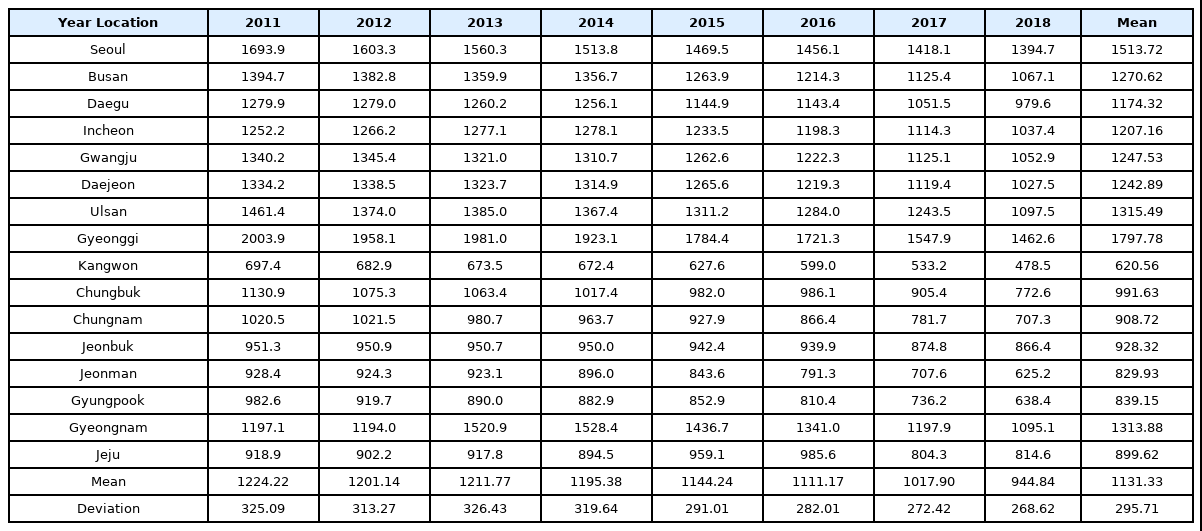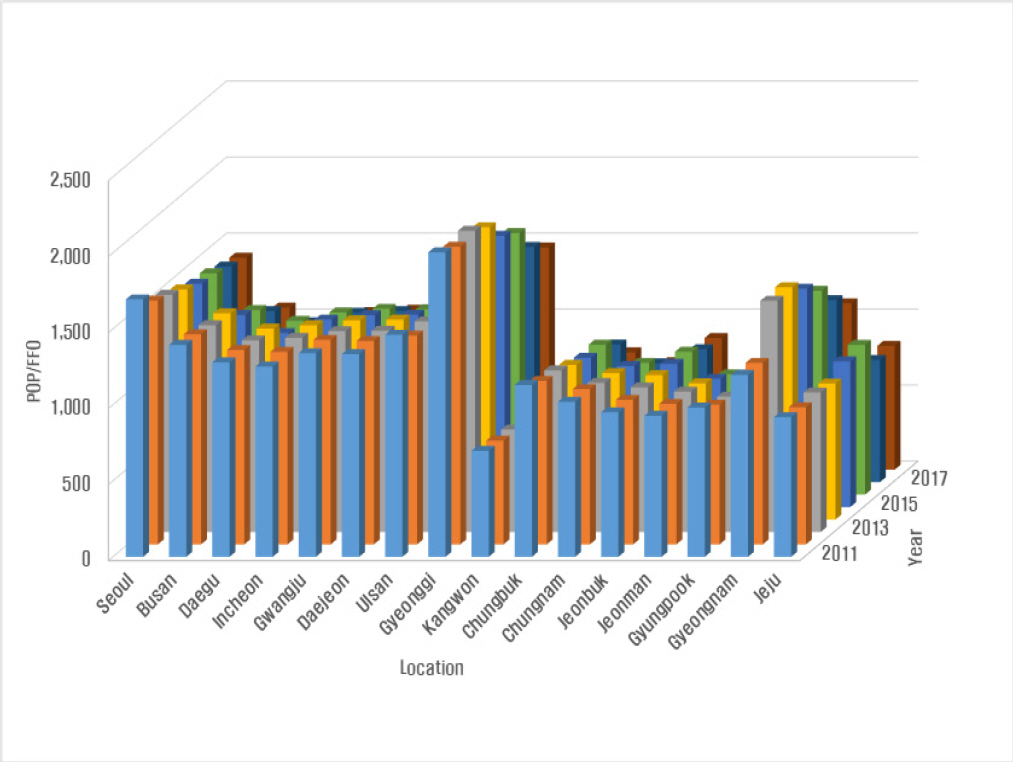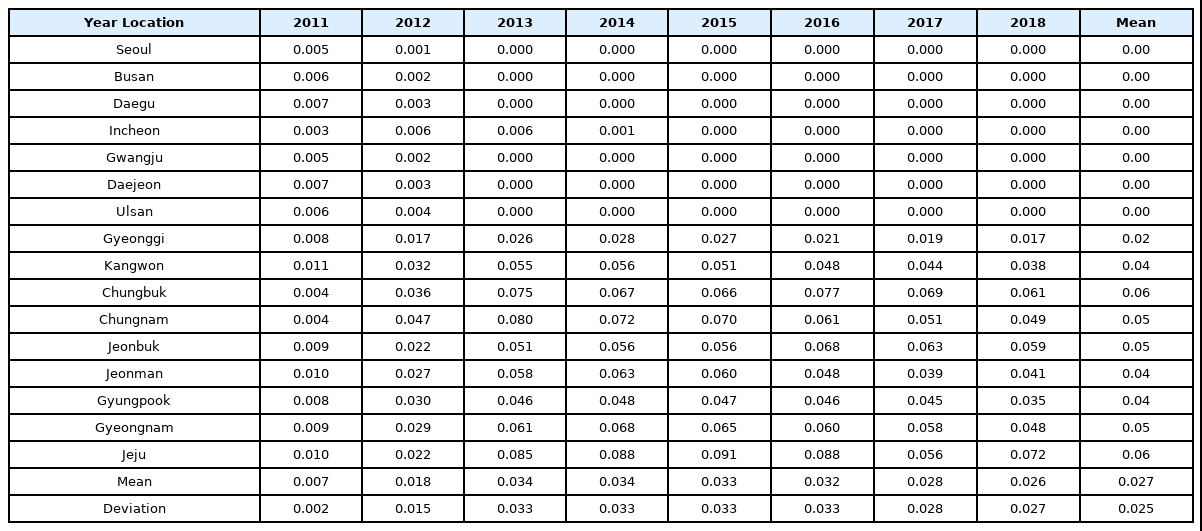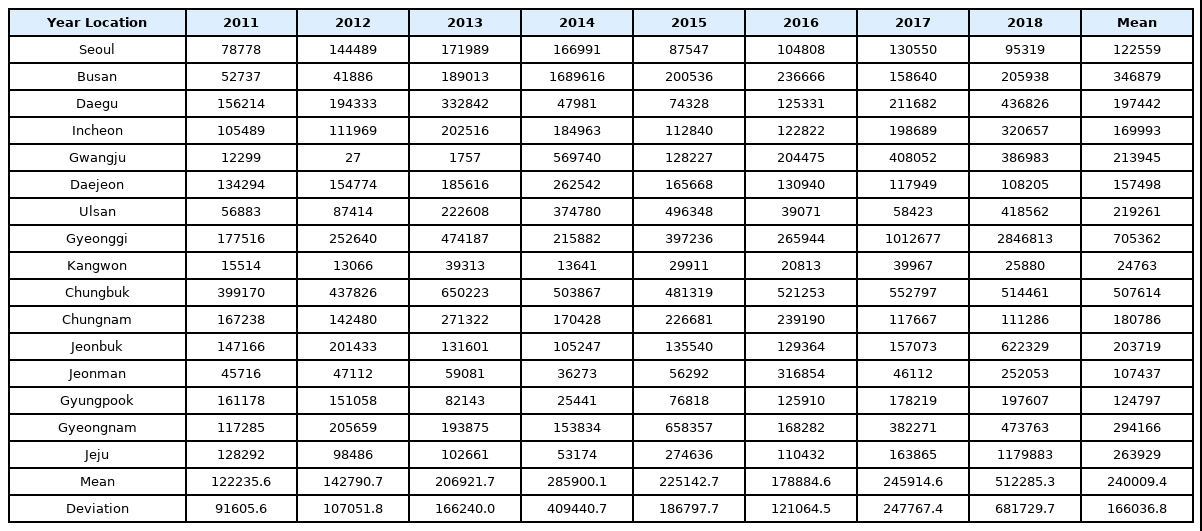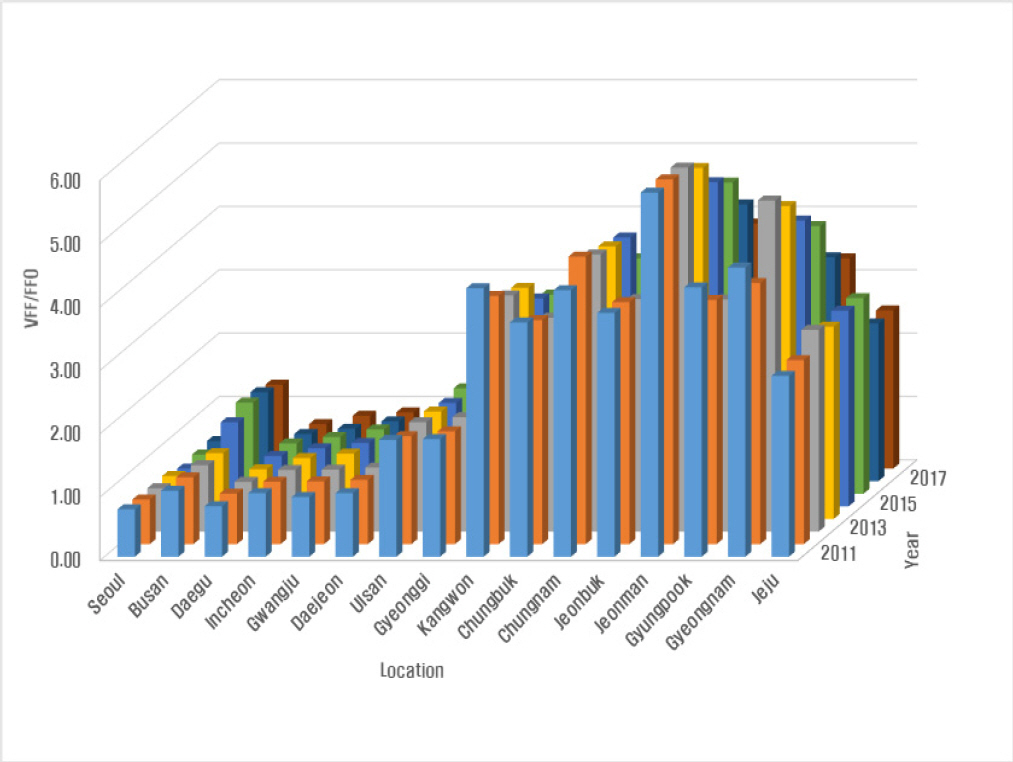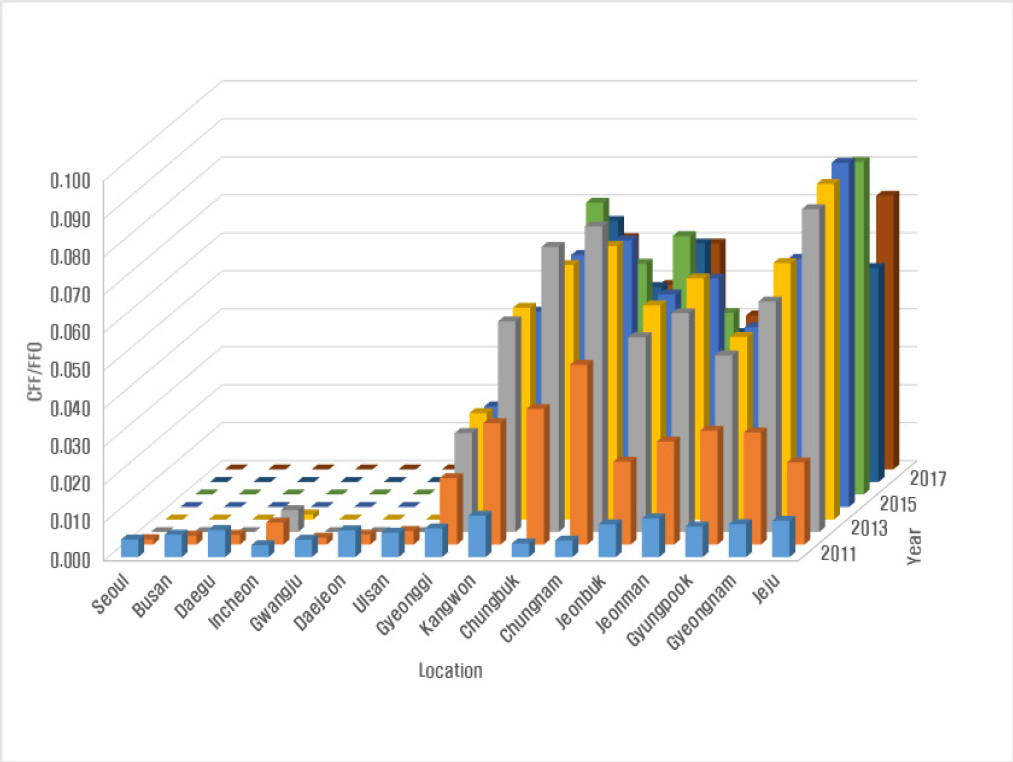Impact of Fire Assistant Personnel on the Reduced Amount of Fire Damage in South Korea
소방보조인력이 화재피해경감에 미치는 영향
Article information
Trans Abstract
Previous studies have examined the status of volunteer fire brigade members, who are classified as firefighting assistants, observed problems in the firefighting administration, and suggested solutions for these problems. These studies are meaningful because they have led to the proposal and implementation of policies for an efficient firefighting administration. However, the references do not provide evidence on how firefighting assistants reduce the amount of fire damage in firefighting administration. Therefore, this study aimed to statistically analyze the impact of fire assistant personnel on the reduction in the amount of property damaged (RAPD) in South Korea. For this purpose, panel data based on firefighting officers (FFOs), volunteer firefighters (VFFs), obligatory firefighters (OFFs), and the RAPD of 16 metropolitan councils in South Korea from 2011 to 2018 were obtained and analyzed. The results demonstrate that population (POP)/FFO, VFF/FFO, and OFF/FFO did not significantly influence RAPD (p < 0.01). However, negative regression coefficients are shown for POP/FFO and VFF/FFO, and positive regression coefficients are shown for OFF/FFO. These results can form an evidence base to explain the relationship between fire assistant personnel and RAPD.
1. Introduction
After the Korean War, South Korea achieved rapidly economic growth and social development by pursuing a government-led growth strategy. The agricultural society was transformed into an industrial society, and the residential and living environment was rapidly developed. The number of high-rise buildings increased, and the population density increased(1,2). South Korea’s economic growth, development of science, and technological advancement have changed the residential and living environment, enabling a materially affluent life. However, new unpredictable and catastrophic accidents began to occur. Additionally, the type of thinking changed because of the large scale, complexity, and diversification(3).
In South Korea, firefighting administrative organizations are responsible for responding to safety accidents, including fires(4-6). In addition, the firefighting administrative services was operated by a vocational civil service system in South Korea. To minimize physical and human damage in safety accidents and, specifically, fires, governments must allocate a sufficient budget and number of fire officials based on the vocational civil service system(7). In other words, a sufficient number of firefighting personnel should be secured because of the redundancy in responding to large and other safety accidents. However, government resources are limited and must be allocated based on social needs, such as equality and equity of administrative services, and operational standards (e.g., the economy and productivity)(8,9). For this reason, fire administration organizations do not always secure sufficient firefighting personnel, reflecting their redundancy(7). In addition, as in other administrative organizations, firefighting administrative organizations have the obligation and responsibility to provide the best administrative services to citizens, reflecting their means of administrative value, such as efficiency, effectiveness, and productivity, regardless of the organization’s size(4,8,9). For example, if a sufficient number of firefighting personnel based on vocational civil service system did not secure, firefighting administrative organizations can not provide the best administrative services to citizens from unpredictable and catastrophic accidents. On the other hand, if the safety accidents do not occur, these sufficient budget and manpower cause ineffectiveness. Hence, a difficult situation occurs in which firefighting administrative organizations must provide firefighting administrative services to citizens, reflecting the conflicting administrative values of redundancy and efficiency.
To solve this problem, South Korea required its fire administration organization to operate firefighting assistants to assist firefighting officers (FFOs)(10,11). The firefighting assistant-based fire-related laws in South Korea describe the positions of volunteer firefighter (VFF) and obligatory firefighter (OFF)(12). Both positions assist in firefighting tasks, such as first aid and rescue activities, in the event of a fire alert, suppression, disaster, or damage. In 2018, the Metropolitan Government Fire and Administrative Organization in South Korea operated approximately 92,000 VFFs and 1100 OFFs, with a budget of approximately 66.7 billion won(13).
The literature on firefighting assistants has mainly used qualitative and quantitative research methods to investigate volunteer fire brigades. Qualitative research has analyzed problems by examining relevant laws and the operational status of volunteer fire brigades and then, based on the findings, suggesting measures to streamline volunteer fire brigades. Jeong(14) demonstrated the purpose and organizational concept of volunteer fire brigades, the introduction of the volunteer fire brigade resident service system, the establishment of a rapid mobilization system, the efficiency of organizational roles and organization, the strengthening of organizational activities, and the resident-friendly image. Lee et al.(15) proposed the development of education programs for volunteer fire brigades, the establishment of organizational and activity ideology, the introduction of a selection system for VFFs, and the establishment of an administrative organization within firefighting administrations. Jeong(16) suggested expanding the activity area of VFFs; invigorating women VFFs; unifying the appointment authority of the captain of the volunteer fire brigade; and efficiently operating specialized, dedicated volunteer fire brigades and elite VFFs. Jeon and Yang(17) proposed diversifying the education for VFFs, securing a base for disaster prevention activities in the region, and expanding the activity area of autonomous disaster prevention activities in the region. Woo(18) suggested ways to invigorate volunteer fire brigades: unification of the captain and members’ rights to appoint and dismiss, elitization of members, basic training of members, and activation of women’s volunteer fire brigades. Kim and Lee(19) proposed ways to invigorate the garden management system that reflect regional characteristics, implement and strengthen cultural education to resolve internal conflict factors, strengthen leadership capabilities of management class members, and establish education and training systems suitable for regional characteristics.
Quantitative research has analyzed problems on the basis of surveys and the statistical analysis of VFFs and then, based on the findings, suggested measures to the promotion of efficiency VFFs. Park(20) surveyed 192 VFFs in Seoul on the type of leadership, trust in the leader, and organizational immersion. The results demonstrated that it has a more significant positive impact on improving organizational commitment than transactional leadership when the type of leadership of the volunteer fire brigade is transformational. According to the analysis results, to increase the organizational immersion of VFFs, the author suggested that the captain of the volunteer fire brigade use transformational leadership rather than transactional leadership and show patriarchal, compassionate leadership in decision-making. Lim et al.(21) surveyed 163 VFFs in Gangwon on their awareness of disasters and continuity of volunteer activities. The results demonstrated that among the subfactors of satisfaction with the activities of the VFFs, the need for experience, social contact, and social recognition had a significant positive impact on the duration of the activities. In addition, social contacts, and achievement motivation in subfactors of activity satisfaction, had a significant positive impact on sustainability. According to the analysis results, the author suggested ways to revitalize the volunteer fire brigade: motivate individuals to participate, cultivate awareness of volunteer activities, and improve the relationship between VFFs and FFOs. Lim(22) surveyed 198 VFFs in Daejeon and Chungcheongnam-do province on their continuity of volunteer activity. The results demonstrated that the relationship among individuals eligible for volunteer work, social recognition, management, education, and training had a positive impact on the continuity of volunteer work. According to the analysis results, the author proposed improving the relationship with individuals eligible for volunteer work, strengthening social recognition, and strengthening the level of management, education, and training as measures to promote volunteer fire brigades. Notably, many other studies of volunteer fire brigades have been conducted(23-28).
Studies have also analyzed the status of members of volunteer fire brigades, who are classified as firefighting assistants; observed problems in the relationships in firefighting administration; and suggested solutions for these problems. These studies are meaningful because they have proposed policies to implement efficient firefighting administration. In addition, research results can be used as empirical evidence to understand the phenomenon of firefighting administration. Other studies have interpreted volunteer fire brigades as volunteer organizations. In addition, it is the same assumption that the VFFs as firefighting assistants positively affect fire administration. In a few studies, the volunteer fire brigade has been interpreted as a sub-administrative organization in a quasi-public organization, but the same assumption is used—VFFs have a positive impact on fire administration(25,28). However, no empirical evidence has been presented on how firefighting assistants affect reduced amount of fire damage in firefighting administration. In other words, the relationship between firefighting assistants and fire administration has not been analyzed as to whether the amount or size of the fire administration exists. In recognition of this problem, this study attempts to analyze the impact of volunteer fire brigades and obligatory fire brigades classified as fire assistants on the reduction of fire damage.
2. Materials and Methods
2.1. Materials
The raw data are secondary data on firefighting assistants, regular firefighters, and the reduction in the amount of property damaged (RAPD). The firefighting assistants are VFFs and OFFs. The regular firefighters are FFOs. These data are results from the operation of firefighting resources from 16 metropolitan and provincial government fire departments in South Korea from 2011 to 2018. In South Korea, there are 17 metropolitan and provincial government. Among them, Sejong Special Self-Governing City was created in 2012. In addition, some of data is has been statistical data since 2012.
2.2. Methods
Qualitative analysis was performed using academic papers, periodicals of the National Emergency Management Agency in South Korea, related laws in South Korea, and major books. Quantitative analysis was performed using statistical analysis. Data for statistical analysis were from the penal structure, which was obtained from “Fire Administrative Data and Statistics”, a National Fire Agency publication. Data on the population (POP) and area (ARE) of metropolitan and provincial governments were obtained from the National Statistical Office. Statistical analysis was performed using statistical package programs (e.g., Stata 14.0 and Excel). The statistical methods used were descriptive statistical analysis, correlation analysis, and panel regression analysis.
Panel regression analysis was conducted to analyze the impact of independent variables on dependent variables and measured the fixed coefficient model and the varying coefficient model. In the fixed coefficient model, a pooled ordinary least-squares (pooled OLS) model was used. In the varying coefficient model, a fixed effect model (OLS-fe) and a random effect model (OLS-re) were used. Before panel regression analysis, multicollinearity and heteroskedasticity were identified by variable inflation factor (VIF) analysis and the Breusch–Pagan/Cook–Weisberg test, respectively. The result of VIF analysis was a value of 4.38; thus, no multicollinearity was observed. The results of Breusch–Pagan/Cook–Weisberg are 167.56 for the chi-square test (chi2) and 0.0000 for the p value; these findings indicate the existence of heteroskedasticity.
Pooled OLS is a method that estimates data in cross-sectional regression while ignoring that the data are panel structures. The probability effect model considering the panel object characteristics is OLS-re. The Breusch–Pagan Lagrangian multiplier test was used to determine whether it was reasonable to estimate the model, pooled OLS or OLS-re. The results showed that chi2 was 1.62, which is a significance probability greater than 0.01. Thus, we estimated pooled OLS rather than OLS-re. Next, the F-test was used to determine whether it is reasonable to estimate the model, pooled OLS or OLS-fe. The F-test tests the following null hypothesis.
If the null hypothesis is accepted, the constant term in the expression below will be equal to alpha (α) for all panel objects. This eliminates the need to consider the heterogeneity of panel objects (equation (2)).
Thus, if the regression model is simply estimated as OLS, a matching estimate can be obtained for the parameter. After all, if the null hypothesis is correct, the model shall be as shown in equation (3).
2.3. Research Model
Figure 1 presents the research model. Independent variables were POP/FFO, VFF/FFO, and OFF/FFO, and RAPD/No. of fire cases. Control variables were POP, ARE, the specific target for firefighting targets (STFF), and urbanization (URB). Definitions of the variables and operational in this study are shown in Table 1.

*Note: Population (POP), Firefighting Officers (FFO), Volunteer firefighter (VFF), Obligatory Firefighter (OFF), Reduction in the Amount of Property Damaged (RAPD), Population (POP), Area (ARE), Specific target for firefighting targets (STFF), and Urbanization (URB)
Research model.
The established regression equation based on the research model is equal to equation (4).
In this case, the meaning of RAPD/No. of fire case, POP/FFO, VFF/FFO, OFF/FFO, and CV is FFO, VFF, OFF reduction amount of property damaged/No. of fire cases, population/FFOs, VFFs/FFOs, OFF/FFOs, and the control variable, respectively. The meaning of α, β1-β3 , β4 and εi t is constant, coefficients of independent variables, coefficients of control variables (population, area, STFF, and urbanization), and the probabilistic error term, respectively.
2.4. Selection of Variables and Operational Definition
POP/FFO, VFF/FFO, and OFF/FFO were used as independent variables. RAPD/No. of fire cases was used as the dependent variable. POP, ARE, STFF, and URB were used as control variables.
This paper focused on the relationship between firefighting assistants and fire administration. Therefore, VFF/FFO and OFF/FFO were used as independent variables, who are firefighting assistants per firefighting-related law. POP/FFO was also used as an independent variable to relatively compare results in the statistical analysis.
RAPD/No. of fire cases was used as the dependent variable and is one of the products of fire administration. In addition, RAPD/No. of fire cases is directly related to the operation of firefighting assistants in fire departments. For example, when a fire breaks out, the volunteer fire brigade is dispatched to extinguish the fire and pursues that endeavor until a regular fire brigade of fire officials arrives. Alternately, when FFOs are extinguishing fires in the fire-causing area, VFFs are dispatched to the later unit to prevent the fire site from developing into a large-scale disaster. OFFs are also dispatched to the fire site to assist when the number of firefighters is insufficient.
POP, ARE, STFF, and URB were used as control variables. POP, ARE, and STFF were used as major variables for the distribution of firefighting resources in South Korea(13). The variables can be influenced by the operation of firefighting personnel. Additionally, the rule of distribution of firefighting resources in South Korea is based on the expenditure needs theory and the model of the fire standardized index(29-31). In the model of the fire standardized index, major variables, for example, POP and ARE, were used. In addition, research on the distribution of firefighting resources has reported that, for example, URB and the location of the fire department are major variables of fire service demands. Because of these reasons, URB was used as control variable.
The operational definition of the selection of variables is as follows. An FFO was defined by the “Fire Officers Act” as a public officer(32). A VFF was defined by the “Volunteer Fire Brigade Establishment & Operation Act” as an individual who assists with activities such as fire suppression, rescue, and emergency relief and with fire prevention activities at a disaster site(10). An OFF was defined by the “Act on the Establishment of Obligatory Firefighting Unit” as an individual who assists in activities such as fire suppression, rescue, and emergency relief and with fire prevention activities at a disaster site(11). An RAPD was defined as the amount of economic loss prevented through firefighting activities(33): in other words, the value of property subject to fire minus the amount of property damage caused by fire. If all the buildings burn down despite the firefighters being dispatched to the fire scene, the RAPD is zero.
3. Results
3.1. Basic Statistics and Correlation Analysis
Tables 3 and 4 present data of the independent and dependent variables. Figures 2~5 are a three-dimensional graph based on Tables 2~5. Table 6 presents the result of a basic statistical analysis of independent and dependent variables from 2011 to 2018.
Table 3 and Figure 2 display data for POP/FFO, and a decrease from approximately 1244 in 2011 to 945 in 2018 was observed. Table 4 and Figure 3 present data for VFF/FFO, and a decrease from approximately 2.67 in 2011 to 1.97 in 2018 was observed. Table 5 and Figure 4 display data for OFF/FFO, and an increase from approximately 0.007 in 2011 to 0.027 in 2018 was observed. Table 6 and Figure 5 present data for RAPD/No. of fire cases, and an increase from approximately 122,235,000 won/incident in 2011 to 512,285,000 won/incident in 2018 was observed.
In Table 3 and Figure 2, POP/FFO continues to decline: POP/FFO was 1224.22 in 2011 and decreased to 944.84 in 2018. If POP/FFO continues to increase until 2022, it is expected to be similar to that of the United States (911) and Japan (779)(34). This result is interpreted as a result of to be due to the continued recruitment of FFOs owing to increased demand for fire safety and recognition of importance. On the other hand, POP/FFO varies greatly by the type of metropolitan government. The metropolitan city and Gyeonggi province had an average of 1300 residents per fire official for 8 years. The result can be attributed to the use of POP and ARE as major variables of the distribution of firefighting resources. According to Attachment 2 of the “Regulations on the Establishment of Local Firefighting Agencies”(35), the criteria for the establishment of 119 safety centers are at least 50,000 residents or 2 Km2 of jurisdiction area. The criteria of small towns are at least 10,000 residents or 20 Km2 of jurisdiction area. In small and medium-sized cities and small-scale towns, the size of the population decreases, and the jurisdiction area widens. For this reason, compared with metropolitan cities and Gyeonggi province, the remaining metropolitan governments have a low resident to fire official ratio.
In Table 4 and Figure 3, VFF/FFO continues to decline: VFF/FFO was 2.67 in 2011 and decreased to 1.97 in 2018. The impetus of this finding is the continued recruitment of fire officials due to the aforementioned increased demand for fire safety and recognition of importance. Additionally, the tendency of VFF/FFO is similar to that observed in Table 3 and Figure 2, which differs greatly by the type of metropolitan and provincial governments. Particularly, the average of the metropolitan cities and Gyeonggi province was 1.1 VFF/FFO, and the remaining metropolitan governments had an average of 3.8 VFF/FFO. In other words, compared with metropolitan cities and Gyeonggi province, the remaining metropolitan and provincial governments operated more VFFs. The results are attributed to limitations on the rule of distribution of firefighting resources in South Korea. Additionally, the rule of distribution of firefighting resources in South Korea is based on the expenditure needs theory and the model of the fire standardized index(29-31). On the basis of this theory and model, the optimal deployment scale of FFOs was calculated using population and area variables(36). This theory and model are based on the logic that if the geographical distribution or density of the population is the same, the increase in demand for firefighting administrative services is likely to be affected(29-31). However, the population decreases, and the jurisdiction area widens as the small cities and small towns decrease in size. Thus, population and area variables do not work independently. This result contradicts the logic that demand for fire administration services increases as areas increase under the assumption that the population distribution between regions is the same. In addition, transportation environments can serve as a crucial variable for providing quality firefighting administrative services, which are difficult to explain. For this reason, it can be inferred we infer that compared with metropolitan cities and Gyeonggi province, the remaining metropolitan governments are utilizing more VFFs to provide fire administrative services to citizens on behalf of the insufficient number of FFOs. In addition, it is indirect evidence of an imbalance between firefighting resources and fire safety service levels that depends on the financial conditions of local governments, which had been claimed by various fields(37-39) before they were changed to state fire officials.
In Table 5 and Figure 4, OFF/FFO increases from 2011 to 2016 and decreases again in 2017 and 2018. Specifically, OFF/FFO was 0.007 in 2011 and 0.026 in 2018. This result can be attributed to the selection of OFFs. From 2011 to 2018, the fixed number of OFFs was 2000, but the number selected was 256 persons in 2011, 650 persons in 2012, and approximately 1150 persons from 2013 to 2018. The obligatory fire brigade is one of the substitute military service systems in South Korea and was introduced to increase the efficiency of firefighting operations and protect the lives and property of individuals by expanding the field activities that are insufficient because of the extent of the demand for fire administration(11). The obligatory fire brigade was established in the wake of a house fire in Hongje-dong, Seoul, in which six FFOs died and three FFOs were injured(37). The “Act on the Establishment of Obligatory Firefighting Unit” was enacted in August 2001 to increase efficiency by expanding the number of firefighters and strengthening the ability to respond to disasters such as fire; in response, 211 OFFs were recruited and began their service with their entry into the Army Training Center on March 29. Additionally, it will be abolished in 2023 after the last recruitment in the first half of 2021.
In Table 6 and Figure 5, RAPD/No. of fire cases continues to increase: from approximately 120 million won in 2011 to approximately 510 million won in 2018. This result is interpreted as economic growth due to social development, and the amount of fire damage caused by large-scale disaster accidents is increasing. Busan in 2014, Gyeonggi province in 2018, and Jeju Island in 2018 show relatively high fire relief, inferred from the large fire in the area in the corresponding year. For example, on August 28, 2018, a fire (property damage was approximately 11 billion won) occurred at Daeyeon Process in Taejeon-dong, Gwangju, and on October 7, 2018, a fire (property damage was approximately 8.8 billion won) occurred at Daehan Oil Pipeline Corporation in Hwajeon-dong, Deokyang-gu, Goyang City.
Table 7 presents the result of correlation analysis between variables. RAPD/No. of fire cases, POP/FFO, VFF/FFO, and OFF/FFO showed no correlation. According to the literature, a Pearson correlation coefficient from 0.8 to 1.0 is very strong positive (+), 0.6 to 0.8 is strong positive (+), and 0.2 to 0.4 is normal positive (+)(40).
3.2. Panel Regression Analysis
Table 8 presents the estimation result of a panel regression model that reflects the heteroskedasticity. Table 9 shows result of research hypothesis. Regarding the result of the F-test in Table 8, if the null hypothesis is accepted, pooled OLS estimation is chosen, and if the null hypothesis is rejected, an OLS-fe model is chosen. The result of the analysis of this study is that the p value of the test statistic is less than 0.01 and that the null hypothesis is rejected at the 1% significance level; thus, we have determined that the fixed effect model is more appropriate than random effect.
The OLS-fe results demonstrated that POP/FFO, VFF/FFO, and OFF/FFO did not significantly affect RAPD/No. of fire cases. Notably, negative regression coefficients are shown for POP/FFO and VFF/FFO, and positive regression coefficients are shown for OFF/FFO. In other words, if POP/FFO and VFF/FFO decrease, RAPD/No. of fire cases increases, and if OFF/FFO increases, RAPD/No. of fire cases increases. The panel analysis results did not demonstrate a significant value; the reason for this finding may be that the demand for firefighting changed from fire control to fire prevention, rescue, and first aid(6). In addition, the reason may be that the ratio of the general volunteer fire brigade, local volunteer fire brigade, and dedicated volunteer fire brigade for extinguishing a fire increased, but the specialized volunteer fire brigade for preparations for large or special disasters did not(13).
In relation to the literature on the distribution of firefighting resources, panel analysis may provide possible evidence to support the opinion that an increase in FFOs has a more positive effect on firefighting mitigation than an increase in VFFs(29-31) and that additional firefighting personnel should be deployed in areas where there is high demand. According to the literature, firefighting policies for VFFs have changed significantly since 2014, when the “Volunteer Fire Brigade Establishment & Operation Act”(41) was enacted. In other words, in 2014, the number of local volunteer fire brigades decreased and the number of specialized volunteer fire brigades increased. The specialized volunteer fire brigade should comprise specialized technical and qualified personnel, and so forth, reflecting regional specialties(42). The specialized volunteer fire brigade was organized to prepare for major disasters that reflect redundancy rather than the purpose of firefighting the initial fire. The trend of an increase in specialized volunteer fire brigades is interpreted as a change in the operation of volunteer fire brigades from the initial firefighting of fire sites to the firefighting assistants of large disasters. For this reason, in terms of RAPD, we infer that the increase in the FFOs has a more positive effect on the reduction of fire damage than the number of individuals in the volunteer fire brigade. In conclusion, it suggests that the number of fire officials corresponding to regular firefighters should be increased to improve the reduction of fire damage and that full-time firefighters should be recruited rather than volunteer firefighters, who are part-time firefighters.
4. Conclusion
This research was conducted to analyze how the volunteer fire brigade and the obligatory fire brigade, who are classified as firefighting assistants, affect the RAPD of the fire administration. For this purpose, an empirical analysis was conducted on FFO, VFF, OFF, and RAPD operated by 16 metropolitan and provincial governments from 2011 to 2018. The analysis results showed that POP/FFO, VFF/FFO, and OFF/FFO did not significantly affect RAPD/No. of fire cases. Additionally, POP/FFO and VFF/FFO showed negative regression coefficients, and OFF/FFO showed positive regression coefficients. We interpret the result as an increase in RAPD/No. of fire cases if the ratio in charge of POP/FFO or VFF/FFO decreases. In addition, we interpret that RAPD/No. of fire cases increases as OFF/FFO increases. These results may provide possible evidence that supports the expenditure needs theory because the increase in fire officials has a more positive effect on reducing fire damage than an increase in FFOs, and additional FFOs should be deployed in areas with a high demand for firefighting. Moreover, to improve RAPD, policy makers should increase the number of FFOs corresponding to regular firefighters, and full-time firefighters should be recruited rather than VFFs, who are part-time firefighters.
This study is significant in that it empirically analyzed the impact of fire assistants on fire damage mitigation. Nevertheless, this study has the following limitations. First, we did not reflect all the characteristics of the volunteer fire brigade, which can be divided into four categories: general volunteer fire brigade, local volunteer fire brigade, dedicated volunteer fire brigade, and specialized volunteer fire brigade. In this study, the interpretation of all this for volunteer fire brigades was beyond the scope of this paper. The second limitation is that we did not consider the work characteristics of the medical fire brigade. Therefore, further research can consider the special nature of metropolitan and provincial governments and the characteristics of volunteer fire brigades.
Acknowledgments
W. Lee mainly contributed to progressing the data acquisition, statistical analysis, and drafting the manuscript. J.H. Lim was mainly contributed to drafting manuscript and manuscript guidance. K. M. Moon mainly contributed to reviewing the final manuscript for publication as the corresponding author.
This research was supported by the Ministry of Land, Infrastructure and Transport of the Government of South Korea (22BDAS-C151631-04).


